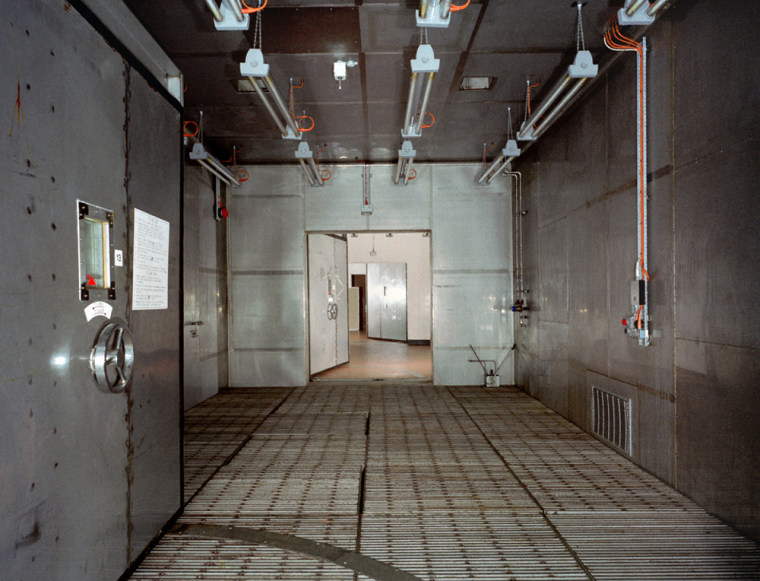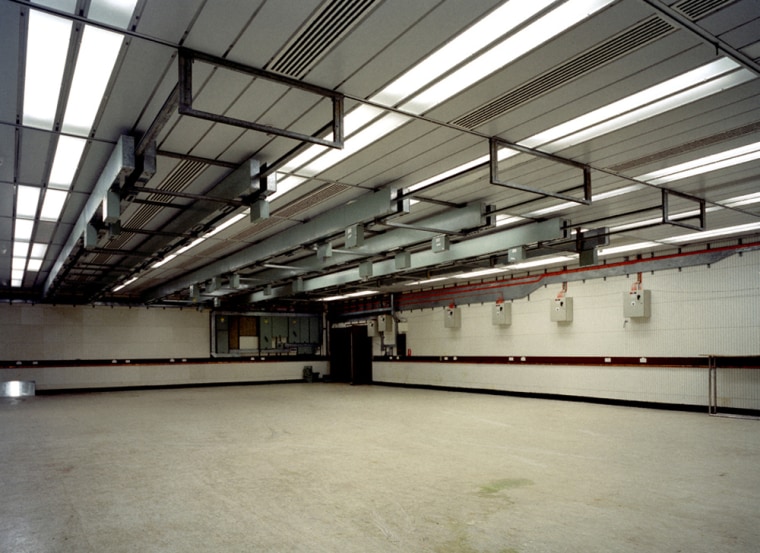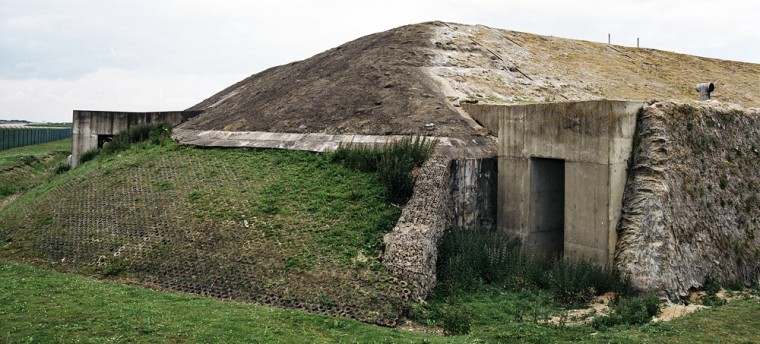It lacks the windswept beauty of Stonehenge or the Tower of London's regal history but that hasn’t stopped a 20-year-old bunker left obsolete by the fall of the Berlin Wall from joining those two landmarks on Britain's fabled list of historic gems.
Appearing to be little more than a weed-strewn hill adjacent to one of Europe's longest runways, "Magic Mountain" was built to ensure that U.S. spy planes could keep flying over Europe in any eventuality — including World War III.
The subterranean structure, designed to survive a direct nuclear attack, was conceived to be a "key NATO asset" as the decades-long showdown between Western and Soviet forces rumbled on. But just months after it was completed in 1989 at a cost of $69 million, thawing East-West relations made the American-built facility a white elephant.
Despite being a tiny blip in the long arc of British history, Magic Mountain has now been designated as a structure of special merit alongside iconic destinations dating back centuries.
Experts with the government-run English Heritage spent about 10 years cataloguing hundreds of Cold War structures around the country — including many formerly secret military establishments.
Officials say Magic Mountain, set on the grounds of the Royal Air Force's Alconbury base in the flatlands of eastern England, was given the protected status because it reflects the "determination to continue operating even in the most extreme horrors of a possible nuclear holocaust."
But the grass-covered edifice isn't just being mothballed or turned into a hushed museum — it's being made to work for living.
Entrepreneurs have caught on to the fact that fortified sites that would cost millions from scratch can be obtained for a fraction of the price. Bomb-proof bunkers now store computer servers, documents and even wine. Hangars at one former U.S. Air Force base are even being used to breed ducks.
"A Cold War structure is about as secure a building as you're ever going to see," said Wayne Cocroft, an archaeologist with English Heritage. "There was a lot of concrete poured in the 1980s."
Cold War atmosphere
Walking through Magic Mountain's blast-proof "guillotine" doors, stainless steel decontamination chambers, airlocks, hatches and life-support systems provides an eerie glimpse back to a time when the end of the world was considered a very real possibility.
The underground avionics and intelligence assessment bunker was used to analyze reconnaissance data gathered by American U2 and TR-1 spy planes during high-altitude, tactical surveillance flights over Europe, historians say.
Magic Mountain also provided a "reassuring" presence for servicemen based at Alconbury, then a U.S.-run airfield about 15 miles from Cambridge and its world-famous university.

David Jimenez, who spent 10 years stationed in Britain as a U.S. Air Force analyst during the Cold War, recounts that it was intended to protect pilots, commanders and other key personnel regardless of how "nasty" conditions became outside.
"There were continually things going on in Europe that had people edgy and there was always the threat that things could go sour at any moment," Jimenez told msnbc.com from his home in El Paso, Texas. "They left nothing to chance. It was so reinforced I'm not sure anything would've been able to make a difference from the outside. If you were going to be anywhere when things broke loose, it's the place you wanted to be."
Officially known as only "Building 210," Magic Mountain boasted a host of up-to-the-minute design features:
- Built of steel and reinforced concrete, it sits on a bed of gravel that allows the double-story structure to shift during an attack, thus absorbing part of the impact. Jimenez said it also was built atop underground "coils" intended to counter ground vibrations in the wake of a nuclear strike.
- It is topped by a reinforced concrete "cap," which was designed to shield the facility from the impact of any direct hit by a missile.
- It featured its own power plant — reputedly providing enough energy to supply a small town — along with air and water-purification facilities, decontamination chambers, photographic dark rooms and electronics workshops.
- Interior air pressure could be kept at a higher level than outside to prevent the entry of poison gases or radioactive contamination. "It was a unique facility," recalled Jimenez. "State of the art. No matter what happened outside, continuity could be maintained in the worst of situations."
- It also featured direct communications links to other U.S. bases across Europe as well as Strategic Air Command's headquarters in Omaha, Neb., and senior Pentagon officials.
"They were trying to design a base that could survive a nuclear attack and protect against biological and chemical warfare," says Cocroft, the co-author of "Cold War: Building for Nuclear Confrontation 1946-1989." "They wanted to sow the seeds of doubt in Soviet military planners' minds that if they struck first that enough NATO assets would survive to give them a bloody nose too."
Activity ceases
The fall of the Berlin Wall on November 9, 1989, marked the beginning of the end for Magic Mountain and many other U.S. military sites across Europe. The bunker stopped being used just months later, and by July 1991, the 17th Reconnaissance Wing that had been responsible for Magic Mountain was inactivated. Two years later, U.S. officials announced that the airfield and its infrastructure would be returned to Britain's Ministry of Defense. While some American military personnel remain based at the now-smaller RAF Alconbury, flying from the site ceased in March 1995.
The millions of dollars invested in Magic Mountain as the Soviet threat waned provides a reminder of just "how sudden and unexpected the fall of the Berlin Wall was," Cocroft said.
Jimenez remembered it being "business as usual" for U.S. Air Force personnel at Alconbury when images of events in Berlin started being broadcast on the BBC.
"It caught everybody by surprise," added Jimenez, who is now an online undergraduate instructor at American Military University. "Nobody foresaw it. A lot of money was spent on that facility. The (collapse of the Berlin Wall) brought everything into question."
Today, buildings and hangars at the 1,000-acre former airfield are rented to a variety of businesses — with part of its runway now serving as a storage depot for shipping containers.
Magic Mountain itself has a slightly more macabre potential use.
After almost two decades of neglect, six local governments have banded together and spent about $115,000 to refit the Cold War relic. In the event of a terror attack or major natural disaster, it has been earmarked as a temporary mortuary.
'Top secret'
Local officials working on its transition say that many mysteries remain about the bunker's past use.
Robert Schiel, principal emergency management officer with Cambridgeshire County Council, said that departing U.S. military officials stripped down Magic Mountain to the walls before leaving it. They took site plans and documentation about its electrical system with them.
"It's a shame there isn't more paperwork from the old days," Schiel said. "While it was operational it was top secret, so what they did in each of the rooms — well, your guess is as good as mine."
Numerous electricity outlets line the walls of the now slightly damp bunker — evidence of the onetime presence of many computers and other high-tech equipment. Part of the lower level features a row of blue air tanks and is reminiscent of a ship's engine room. The wall in another section bears the painted slogan: "Aircrews live by the knowledge, skill, awareness and integrity of their maintenance people."

Overall, though — and if access didn't require a journey through a tunnel and a series of blast doors — much of the underground structure's interior is much like a typical office block.
Nonetheless, David Farrant, who runs a Cold War history Web site, describes Magic Mountain as "quite breathtaking".
"It just looks like a lump in the ground but it was so well-built I'd hate to have to knock it down," said Farrant, 54, who says he has a passion for exploring places that were once banned from appearing on maps. "It's such a unique thing and cost so much that it's worth trying to find a use for it."
Ducks and potatoes
Meanwhile, several other former American military sites in Britain also have been given a new lease on life.
Vintage buildings and hangars at Bentwaters Parks, a onetime U.S. Air Force base in nearby Ipswich, have become popular with television and film production companies. Its main runway was once transformed into a desert complete with palm trees for a documentary and hardened aircraft shelters have been used for growing potatoes and raising ducks.
During the 1980s, the former base at Greenham Common, to the west of London, housed dozens of U.S. nuclear missiles and featured a direct communications link to the White House. Complete with 5-foot thick reinforced concrete walls, the Berkshire facility's command-and-control center is now billed as a "ultra-secure" site for computer servers which promises to protect clients' data "from every eventuality." In April, its owner announced plans to invest about $20 million to upgrade the site.
However, the long-term economic future appears less certain for Alconbury's airfield and Magic Mountain.
One proposal would see up to 6,000 homes built there by 2031. Other plans to see the base transformed into a rail terminal or cargo distribution center have surfaced and then faded in recent years.
In fact, locals worry that Magic Mountain's designation as a historic site — which means that major alterations cannot be carried out to the bunker — will make it difficult to redevelop the rest of the vast airfield.
At the ivy-covered Stukeleys Country Hotel, a 16th-century pub near the base, co-owner Liam Drumm has a potential solution.
"It's a dinosaur of the Cold War," he said. "We don't have a Shakespeare to attract tourists to this part of England so why not make it a Cold War museum?"
